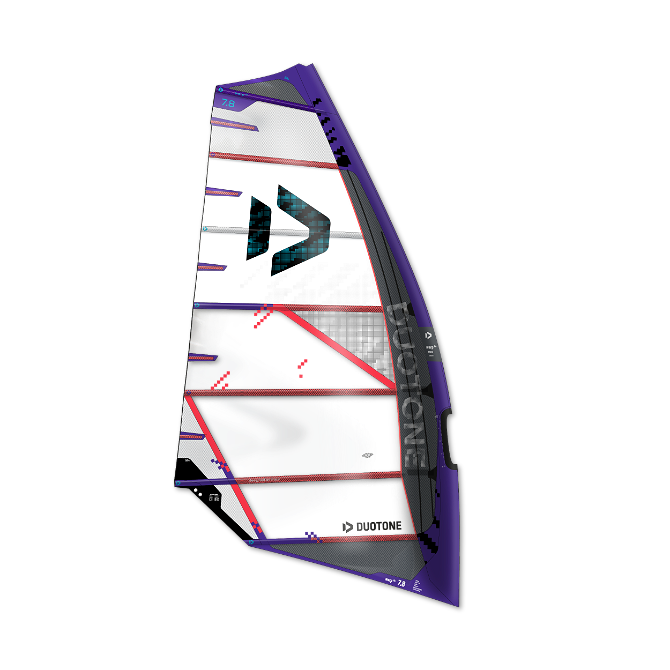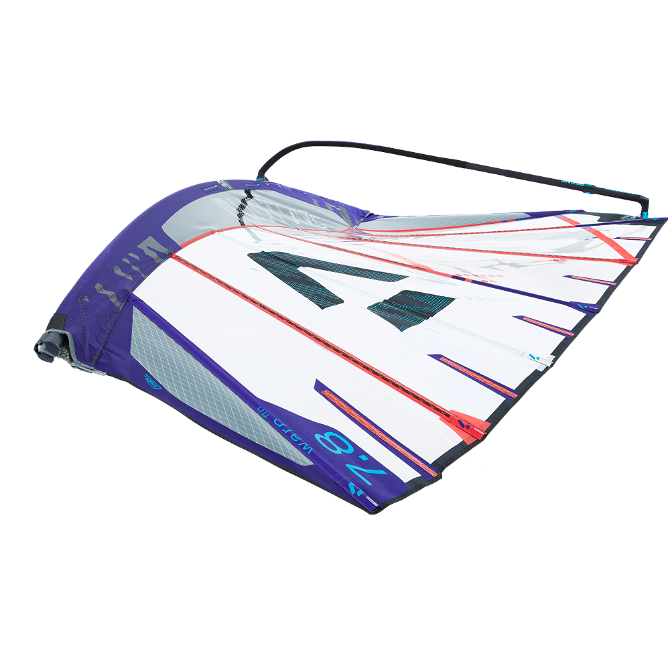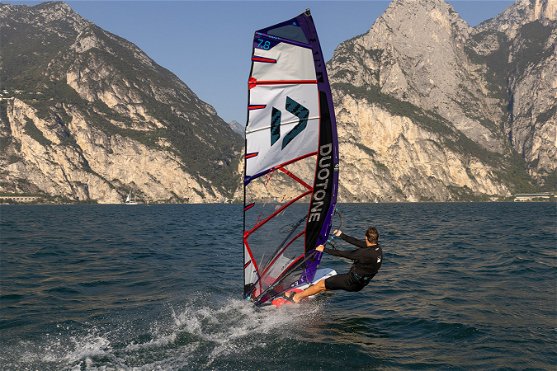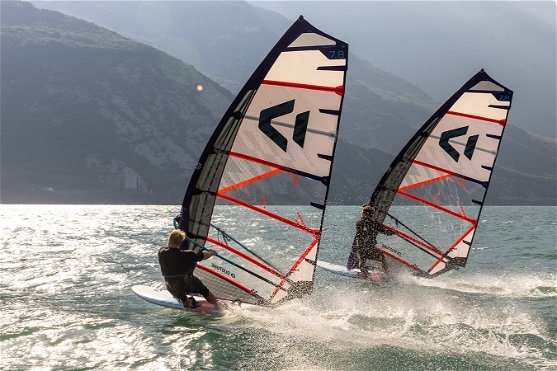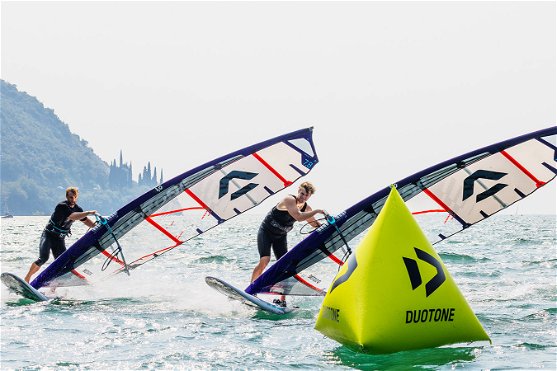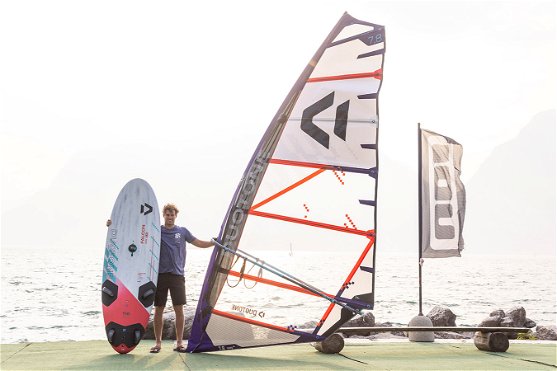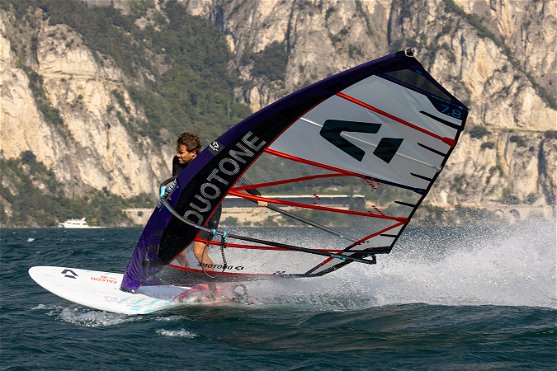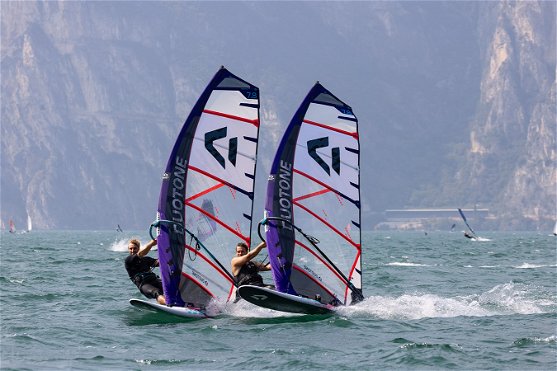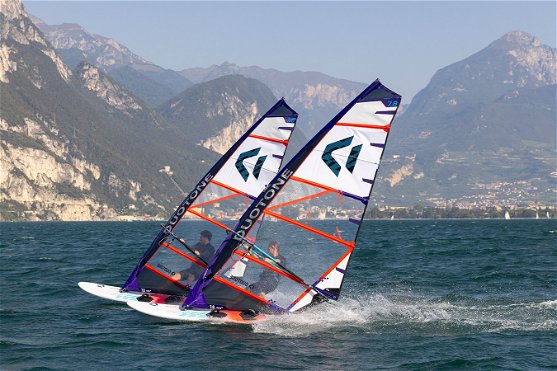Warp_Fin 2024
A VELA DE SLALOM MENOS FÍSICA E MAIS COMPETITIVA DO EXTERIOR. 8 CAMPEÕES MUNDIAIS DE SLALOM E 20 PODIUMS DE CLASSE MUNDIAL FALAM POR SI MESMOS!
C31:white/black
A PWA Fin Racing está de volta e temos um pacote imbatível para você!
Após o redesenho em 2022, modificamos e ajustamos constantemente cada tamanho e podemos dizer com firmeza que as mudanças que fizemos levaram às melhores velas de corrida de slalom que já fizemos.
Como validamos essa afirmação? Bem, para começar, em 2023 fomos a única marca a vencer uma corrida de slalom da PWA, com Pierre Mortefon e Jordy Vonk conquistando vitórias contra as Foils. Acrescente isso aos 8 campeões mundiais de Slalom e aos 20 pódios de classe mundial em 2022 e as estatísticas de corrida dessas velas falam por si. Com muitos desempenhos juniores de alto desempenho também, a WARP_FIN não é apenas a mais adequada vela de corrida para os atletas profissionais de classe mundial, mas também para os juniores de melhor desempenho. Para todos os tamanhos e níveis de habilidade, a WARP_FIN é a mais adequada vela de corrida fin-slalom do mercado.
O que fizemos para criar uma vela tão incrível? Em primeiro lugar, a WARP_FIN está pronta para competir logo que sai do saco.
Ao contrário da maioria das outras velas de corrida de slalom, a WARP_FIN não precisa de nenhum ajuste fino demorado. Mesmo com as nossas velas de corrida de slalom, o o objetivo é que você tire a vela do saco, ajuste-a de acordo com os marcadores visuais e tenha a certeza de que terá o mesmo desempenho que a nossa equipe de corrida. Nas corridas, a aceleração máxima e o controle sobre o material são o que conta quando se trata de ficar no topo do pódio. É preciso ter velocidade e controle máximos
no percurso, mas também ser capaz de velejar por muitas horas seguidas para vencer no final da semana. O design mais pronunciado do High Aspect Ratio, especialmente nos tamanhos maiores, com um comprimento de lança reduzido e um perfil deslocado para a frente, requer menos potência, é mais leve nas mãos e oferece mais controle no limite superior do vento. Além disso, as ripas de tubo mais rígidas estabilizam bem a forma na faixa de potência excessiva e você pode converter facilmente até mesmo rajadas monstruosas em velocidade extra.
No geral, o WARP_FIN é mais equilibrado, menos cansativo e ainda mais controlável.
Por outro lado, a aceleração também foi aprimorada para recuperar terreno após a largada e os jibes. Com base no bem-sucedido conceito NO COMPROMISE DESIGN, a posição do draft foi movida um pouco mais para cima, para elevar a prancha
o que leva a um melhor aplainamento e a uma aceleração explosiva graças à resistência reduzida. O PROJETO SEM COMPROMISSO também possibilitou que a propulsão não começasse abruptamente e precisasse ser "forçada", mas aumentasse de forma muito mais gradual e suave do que com outras velas de slalom de potência! Isso alivia o piloto, dando-lhe reservas extras de potência para todo o percurso e concentração total na corrida. Há outros efeitos colaterais positivos da geometria do perfil modificado com uma posição de calado mais alta: o caimento da prancha mais adequadaa, facilitando o voo na amurada e, em combinação com a rotação de curvatura suave incomparável, a vela faz jibes ainda mais rápido e sem esforço.
Nos últimos 12 meses, cada tamanho foi ajustado com perfeição, modificando a curva do luff, a distribuição do perfil e o padrão de torção. Como resultado, todos os tamanhos:
- têm uma aceleração ainda mais explosiva agora
- oferecem uma faixa de vento ainda maior
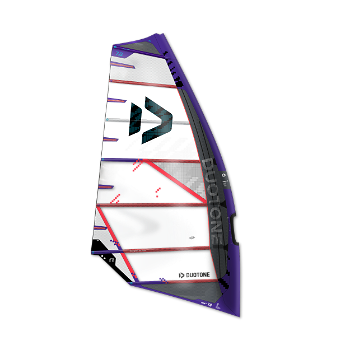
ATTENTION: since the mast geometry and length (= stiffness) depend on the sail design, size and luff curve the sails will NOT work with any masts outside the recommendations!
RECURSOS TECNOLÓGICOS
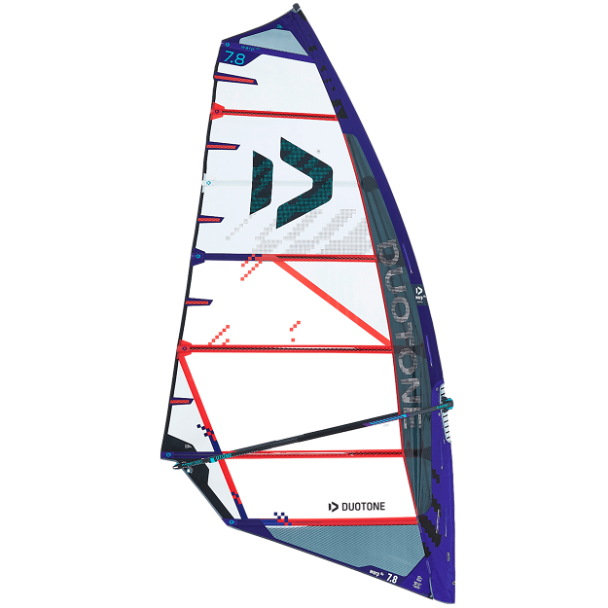
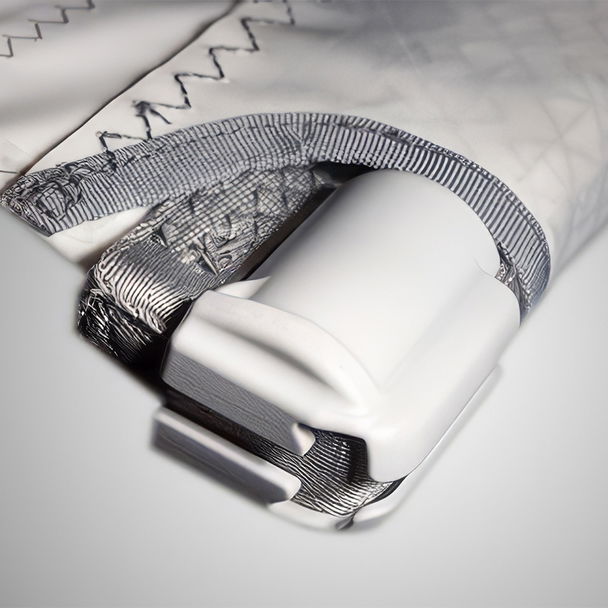
SUA COMBINAÇÃO PERFEITA COM A DIRETORIA
JAG
Opiniões
BASE DE CONHECIMENTO VELAS
COMPATIBILIDADE DE MARCA
Na DUOTONE, usamos uma Curva Constante Média para nossos mastros (nossas porcentagens de curvatura variam entre 61-63 na parte inferior e 75-77 na parte superior, dependendo do modelo e do comprimento). Como essa curva fica bem no meio dos mastros Constant Curve, ela oferece a maior compatibilidade de qualquer curva de curvatura. Isso faz com que nossos mastros e velas sejam os mais compatíveis do mercado.
VEJA COMO OS MASTROS DE OUTRAS MARCAS FUNCIONAM BEM COM NOSSAS VELAS E VICE-VERSA:
Challenger Sails, Ezzy, GA (2017 em diante), Goya, Gun Sails, KA Sails, Loft Sails, Naish Sails, NeilPryde (mastros RDM), RRD, S2Maui, Sailloft, Sailworks, Severne (mastros RDM, 2014 em diante)
>> 80-90 (dependendo do modelo e do tamanho)
Hot Sails, NeilPryde (mastros SDM), Point7, Severne (mastros SDM, 2014 em diante), Simmer Style, Chinook
>> 70-80% (dependendo do modelo e do tamanho)
Avanti, Gaastra (até 2016), Maui Sails, Severne (até 2013), Vandal
>> Não compatível
A maioria dos clientes muda seus tamanhos individuais de vela e mastro de acordo com a demanda e, portanto, acaba possuindo um quiver de diferentes marcas. Ao montar seu quiver pessoal de velas, você deve tentar combinar velas que tenham uma sensação e um comportamento semelhantes. O único fator decisivo que define a semelhança ou diferença entre a sensação e o comportamento de uma vela e outra é a posição do calado, em ambos os níveis, vertical (alto><baixo) e horizontal (frente><trás).
Atualmente, as velas de freeride e slalom de diferentes marcas são bastante semelhantes, pois pelo menos a posição de inclinação horizontal é orientada para a frente em quase todas as velas atuais.
A maior diferença, porém, está nas velas onduladas.
Basicamente, existem dois tipos diferentes de velas onduladas:
Calado centralizado (= tração equilibrada em ambas as mãos) e baixo (para manter a vela controlável)
Essas velas são a companhia ideal para pranchas com várias quilhas. Como a tração equilibrada em ambas as mãos as torna super neutras em suas mãos, elas brilham especialmente em condições reais de down the line. Por outro lado, a sensação é muito diferente das velas de freeride e slalom modernas (que são muito puxadas para a frente). Portanto, se você estiver usando essas velas de draft back/low wave apenas muito ocasionalmente como sua vela de vento forte em águas planas, talvez seja melhor usar o segundo tipo de vela para ondas.
Esboço para frente e para cima (para ainda gerar potência baixa suficiente)
Essas velas funcionam tanto em pranchas com uma ou várias quilhas. Com a sensação de puxar para a frente, elas são mais fáceis de sair/diretas para velejar e têm uma sensação muito semelhante às velas de freeride e slalom modernas. Além disso, elas são a escolha ideal para condições de salto de lado a lado com a costa, pois o calado mais alto e orientado para a frente ajuda/acelera as rotações no ar (especialmente os loops para a frente).
Portanto, ao misturar seu quiver com velas/marcas diferentes, você deve tentar combinar velas que tenham uma posição de calado semelhante e, portanto, sensação e comportamento.
Basta seguir estas diretrizes:
Você está procurando uma vela para ondas com sensação direta, especialmente para saltos. Ou precisa de uma vela menor para completar suas velas de freeride ou slalom. Tente obter velas de proa/onda para cima. Exemplos típicos são:
Duotone Super_Star / Duotone Duke / NP Zone / NP Combat (até 2018) / NP Atlas / Point7 Salt / Point7 Spy / Severne S1 / Severne Blade
Você está procurando uma vela para ondas que seja super neutra para andar na linha e muito tolerante em condições de rajadas fortes. Tente obter velas com calado centralizado/onda baixa. Exemplos típicos são:
Duotone Super_Hero / GA IQ / GA Manic / Goya Fringe / Goya Banzai / NP Combat (2019 em diante) / Simmer Tricera / Simmer Blacktip / Simmer Icon
Tente evitar combinar velas de calado para frente/para cima com velas de calado centralizado/baixo em seu quiver, pois elas têm sensações e comportamentos extremamente diferentes.

FÍSICA DO PROJETO DAS VELAS DE WINDSURFE MODERNAS
Especialmente na parte superior e na direção do punho, o peso é fundamental, pois, devido ao efeito de alavanca, você sente cada grama várias vezes em suas mãos. Devido à quantidade bastante limitada de materiais disponíveis, a única maneira de reduzir o peso da vela é reduzindo a espessura dos materiais. O segredo é encontrar o ponto ideal para o menor peso possível, mas sem sacrificar a durabilidade e a longevidade/sustentabilidade.
As velas de windsurfe modernas consistem nas seguintes matérias-primas:
(1) MATERIAL DA LUVA DO MASTRO
Tecido de poliéster com trama áspera. A estrutura áspera oferece resistência máxima à abrasão contra impactos externos (por exemplo, contato com a prancha ou contato durante o rigging) e internos (através do mastro).
(2) MONOFILME
Filme plástico feito de poliéster disponível em versões transparentes ou coloridas. Esse filme plástico rígido tem uma elasticidade muito baixa (para desempenho máximo) e não absorve água (peso seco = peso úmido). Atenção: o monofilme não é muito resistente aos raios UV. Portanto, mantenha sua vela longe da luz solar direta quando não estiver velejando. O monofilme também não é muito resistente à abrasão.
(3) LAMINADO XPLY
2 camadas finas de monofilme e um padrão de fios (de poliéster ou Dyneema) são colados juntos, criando um laminado sanduíche. As linhas adicionais devem funcionar como um limitador de rasgos caso o filme seja perfurado (por exemplo, ao cair na vela com o gancho do arnês primeiro). Ao usar a mesma espessura total do monofilme (= mesma baixa elasticidade, mesma resistência a UV e a perfurações), o XPly é 30% mais pesado devido ao adesivo adicional (e às linhas).
(4) DACRON
Antes de descobrir o monofilme, as velas originais de windsurfe eram feitas inteiramente de Dacron. Esse tecido oferece uma resistência muito boa à abrasão, mas é muito elástico e se alonga (ou seja, cresce a cada uso). Portanto, hoje em dia é usado principalmente em remendos de reforço para proteger o monofilme e os painéis XPly nas áreas de alta abrasão de sua vela (pé, punho, topo e parte externa dos bolsos das ripas).
(5) INSIGNIA
Material de dacron com um lado autoadesivo. Portanto, ele não requer costuras quando colocado sobre o filme, além de evitar que a água fique entre o filme e os adesivos de abrasão (= menor peso úmido).
Quer saber mais detalhes ou está procurando peças de reposição para velas DUOTONE - Aqui está

BATTENS
Feito de fibra de vidro ou de carbono, seja na versão sólida com diâmetro menor (= mais forte) ou na versão tubular com diâmetro maior (= mais rígido). Para uma melhor compreensão, o mastro é como a espinha dorsal de sua vela, enquanto as ripas agem como as costelas de sua vela, mantendo o perfil no lugar. Da mesma forma que o mastro, as ripas também têm perfis individuais (ponta mais fina, cauda mais grossa) que combinam com o perfil da vela.
Regra simples: quanto mais ripas, mais estável (= mais rápida + maior alcance do vento) a vela se torna. Mas também mais pesada a vela se torna, pois as ripas representam aproximadamente 40% do peso total da vela. Portanto, as velas orientadas para o manuseio/ondas geralmente vêm com 4-5 ripas, enquanto as velas orientadas para o desempenho geralmente vêm com 6-7 ripas.
Como segunda diretriz, velas de tamanhos menores exigem menos ripas do que as de tamanhos maiores.
CÂMERAS
Normalmente, há um certo espaço entre a ponta da vela e o mastro. Isso é necessário para que a ripa possa se deslocar de um lado do mastro para o outro ao navegar para frente e para trás. A curvatura pode ser vista como um tipo de conexão entre a ponta da ripa e o mastro, preenchendo essa lacuna.
Isso resulta em uma aerodinâmica muito melhor, pois o came permite uma transição suave entre o mastro grosso e o corpo fino da vela. Além disso, como o came está apoiado contra o mastro, o sarrafo estabiliza o perfil da vela com muito mais eficácia (a vela fica mais estável = mais rápida).
A desvantagem é que a rotação de um lado para o outro se torna muito mais difícil. Além disso, os cambers precisam de um certo espaço, o que exige uma manga de mastro mais larga. Isso torna a partida (na água) muito mais difícil, pois a manga do mastro mais larga absorve mais água. Portanto, os cambers são usados principalmente em velas de Freeride de alto desempenho ou de Slalom de alto desempenho.
CACHORRO DO PÉ
Uma vela com muita barata no pé reduz o espaço entre a vela e a prancha (fecha o espaço), o que a torna mais eficiente e orientada para o desempenho.
Por outro lado, um pé de corte alto com menos barata no pé melhora o manuseio, especialmente para todos os tipos de movimentos de abaixamento.
PROFUNDIDADE DO PERFIL
Um perfil de vela mais profundo lhe dá mais potência e desempenho em geral.
Um perfil mais plano, por outro lado, melhora o manuseio, pois a distância do perfil plano é muito menor quando se muda de um lado para o outro.
COMPRIMENTO DA LANÇA E DO CABO
Juntamente com o tamanho da vela, todas as dimensões aumentam. Isso significa que, em geral, quanto maior a vela, maiores serão os comprimentos da retranca e do punho.

Regra simples: um velejador mais pesado precisa pegar uma vela maior para conseguir planejar com o mesmo vento em comparação com um leve.
Indicação aproximada para o maior tamanho de vela: para ir com o mesmo vento, um indivíduo 10 kg mais pesado precisa de uma vela 1 m² maior.
Tamanho máximo da vela vs. peso corporal:
Quanto maior a vela, mais pesada e mais "lenta" a plataforma se torna. Além disso, velas maiores exigem mastros mais rígidos para manter a superfície "em forma". Um piloto pesado fornece mais "contrapressão" à área da vela e à rigidez do mastro do que um leve. É por isso que a vela tende a desequilibrar, fica difícil de controlar durante as manobras e torna-se ineficiente para bombear quando é grande demais para o seu peso corporal.
Em relação ao seu peso corporal, há um tamanho máximo de vela que não deve ser excedido.
Aqui estão algumas diretrizes:
>> 9.0+: peso corporal mínimo de 95 kg
>> 8,0-8,3: peso corporal mínimo de 80 kg
>> 7,0-7,3: peso corporal mínimo de 70 kg
Como regra geral, é preferível usar uma vela um pouco menor do que uma grande demais.
Primeiro, você deve definir o maior e o menor tamanho de vela de que precisará para cobrir todas as velocidades de vento em que deseja velejar. Isso depende principalmente de seu peso corporal (veja acima).
Vamos considerar um velejador "médio" de 75 kg e vamos supor que ele queira velejar em "qualquer tipo" de vento.
- O maior tamanho de vela de que esse rapaz precisaria é algo como um 7.3. Com uma prancha Freeride de 100-120 litros, esse tamanho o levaria a planejar em aproximadamente 8-10 nós.
- Seu menor tamanho seria então um 3.7. Em uma prancha de 70-80 litros (Free)Wave, nosso rapaz deve estar bem até aproximadamente 40-45 nós.
A segunda coisa é definir os tamanhos intermediários. É importante saber: a pressão do vento (que você sente em suas mãos) aumenta ao quadrado em relação à velocidade do vento. Portanto, quanto menor o tamanho da vela, menores devem ser os incrementos de tamanho. Para velas grandes, o espaço pode ser de até 1,5 m², enquanto para velas muito pequenas pode ser de até 0,3 m².
Levando tudo isso em conta, uma aljava típica para nosso homem de 75 kg poderia ser a seguinte:
7.3 - 6.0 - 5.3 - 4.7 - 4.2 - 3.7
Levando em consideração a regra "10 kg = 1 m²" (veja o ponto anterior), uma aljava típica para um homem de 85 kg poderia ser:
8.3 - 7.0 - 6.0 - 5-0 - 4.5 - 4.0
Você comprou todas as peças da mesma marca, mas se você montar o equipamento de acordo com as especificações impressas na vela, ele ainda parecerá um pouco estranho.
Infelizmente, todo produto tem tolerâncias na produção. E quanto maior for o produto, maiores serão as tolerâncias. Portanto, as tolerâncias em um smartphone são pouco visíveis, enquanto as tolerâncias em equipamentos de windsurfe são inegáveis.
- As tolerâncias no comprimento do mastro são de aproximadamente +-5 mm.
- As tolerâncias das extensões de mastro e das lanças são de aproximadamente +-3 mm.
Além disso, infelizmente ainda não existe um padrão entre as marcas sobre como medir o comprimento das lanças e extensões.
- Em uma vela com todos os seus painéis, as tolerâncias ao longo de todo o comprimento do punho podem somar mais +5-10 mm.
Além disso, mesmo com velas monofilme, o luff se estica nas três primeiras vezes em que você usa a vela devido à enorme tensão do downhaul.
Ao somar todas essas tolerâncias, você começa a perceber por que os números absolutos impressos em sua vela (especialmente o comprimento do punho) podem ser apenas uma indicação para ajustar os comprimentos da extensão do mastro e da retranca.
Para obter a tensão correta de downhaul, certifique-se de confiar apenas nos marcadores VTS (Visual Trim System) na parte superior de cada vela DUOTONE.
Tenha sempre em mente que há exatamente duas coisas que podem matar pelo menos 30% do desempenho de suas velas:
1. O mastro errado (veja o primeiro ponto em BÁSICOS DO MASTRO em{{ESPAÇO}}cada página do mastro)
2. Tensão incorreta/insuficiente do downhaul
Há duas coisas que destruirão até 60% do desempenho de suas velas:
1. Um mastro errado, com uma curva de curvatura que não combina com a curva de luff de sua vela
2. Uma vela mal programada
Para saber como montar e ajustar sua vela, consulte nosso Canal do YouTube.
Sempre arme o equipamento de acordo com as instruções de armamento - consulte aqui.
Após o uso em água salgada, enxágue ou borrife com água doce. No mínimo, ao final de uma viagem ou férias.
Quando possível, enrole a vela somente depois que ela estiver seca. Nunca guarde uma vela enrolada por longos períodos de tempo, a menos que esteja seca.
Para secar, libere a tensão da vela; se possível, não a coloque para secar sob a luz direta do sol e não a seque deixando-a balançar ao vento.
Sempre enrole a vela de cima para baixo, mantendo todas as ripas sob tensão total em suas mangas!
Use apenas os componentes de mastro recomendados para sua vela a fim de obter o melhor desempenho.
Não lave sua vela com detergentes fortes ou produtos químicos. Água e sabão neutro são suficientes.
Conserte imediatamente os rasgos e furos nas velas de monofilme para evitar mais rasgos. Se o reparo adequado for impossível (e isso inclui o uso do kit de reparo de monofilme DUOTONE), pelo menos sele o rasgo com fita adesiva normal ou um adesivo.
A durabilidade das velas está diretamente relacionada a
a. a frequência de uso
b. cuidados com a vela e
c. Radiação UV (especialmente em velas de monofilme)
Em locais com alta radiação UV, armazene a vela na sombra, caso contrário, retire-a do casco.
FILOSOFIAS DE DESIGN DUOTONE - PENSE DIFERENTE
Com o excesso de informações nos dias de hoje, ninguém mais tem tempo para ler manuais. Por isso, nos esforçamos muito para projetar nossos produtos da forma mais intuitiva possível para que você possa entrar na água mais rapidamente do que com qualquer outro produto. Não é à toa que o DUOTONE é chamado de campeão mundial de recursos.
Aqui estão alguns exemplos:
VTS 2.0
O primeiro guia visual de trimming "sem suposições" que mostra claramente a tensão correta do downhaul. A versão 2.0 vem com uma janela no protetor para marcar seu trim individual depois de encontrar a configuração ideal.
HTS 2.0
Ao marcar a posição do calado na vela, você saberá imediatamente onde posicionar os cabos do chicote.
INDICAÇÃO INDIVIDUAL DO COMPRIMENTO DA LANÇA
O comprimento da lança muda com o ângulo do mastro. Portanto, se você mover a retranca para cima ou para baixo, precisará alterar o comprimento da retranca. Como a única marca que leva isso em consideração, imprimimos três comprimentos diferentes de retranca no punho e no recorte da retranca para que você sempre saiba o comprimento correto de acordo com a altura do seu corpo/tronco.
SET&GO VARIO-TOP
Em vez de deixá-lo com o demorado procedimento de tentativa e erro para encontrar a configuração correta, instalamos marcações na cinta que mostram imediatamente a configuração correta.
iROCKET 2.0
Cada ripa em uma vela requer uma tensão diferente. É por isso que, como a única marca, calibramos cada ripa na fábrica para a tensão individual correta usando uma chave de torque. Como os parafusos são travados com cola de parafuso, você nunca precisa tocá-los. Fique tranquilo e tenha sempre a tensão perfeita das ripas.
Nosso lema é claro: a luz está certa, mas somente se não custar caro em termos de durabilidade.
Nossos produtos de hardware (lanças, mastros e extensões) são comprovadamente os mais leves do setor.
Com nossas velas, embora não sejamos as mais leves do mercado (com exceção da Super Hero M.Plus). A principal razão para isso é que estamos usando laminados XPly (muito) mais espessos do que algumas outras marcas.
Os fatores de resistência a perfurações, resistência a intempéries UV e estiramento evidentemente dependem APENAS da espessura do filme usado.
A resistência a perfurações e o estiramento têm uma relação linear com a espessura do filme. Isso significa que o dobro da espessura resulta no dobro da resistência contra perfurações com a metade do estiramento.
Ainda mais crítica é a resistência aos raios UV, pois aqui a relação com a espessura é superproporcional. Significa que metade da espessura reduz a longevidade UV em quase 70%!
Algumas marcas usam laminados XPly que são 2/3 mais finos do que os nossos na área superior da vela. Sim, na parte superior, você tem menos problemas de perfuração e pode até mesmo se safar com o aumento da tensão. Infelizmente, porém, a exposição aos raios UV é a mesma em toda a vela.
Essa é uma das razões pelas quais a maioria dos centros de windsurfe em todo o mundo confia nos produtos DUOTONE.
Eliminando o estiramento e a perda de tensão. Se é bom o suficiente para cintos de segurança, é bom o suficiente para windsurfistas! Somos o único fabricante a usar somente cintas de poliéster para a parte superior (vario) e o rolo de aderência. A vantagem desse material em comparação com o polipropileno convencional é a quantidade insignificante de elasticidade. Como resultado, mesmo as velas novas manterão a tensão total do punho e não precisarão ser aparadas posteriormente.
Nas velas de ondas modernas, é necessário ter certa elasticidade. A maneira mais fácil de "injetar" elasticidade em uma vela é usar Dacron no painel de luff.
No entanto, o Dacron tem duas desvantagens:
O Dacron é um tecido bastante macio. Portanto, ele tem muita elasticidade, mas, assim como a sua camiseta, ele se desgasta com o tempo. Isso significa que a sua vela está permanentemente ficando mais cheia no painel do punho. Especialmente sob tensão permanente do downhaul (por exemplo, em centros de surfe), o Dacron envelhece muito rapidamente.
O material de Dacron melhora a elasticidade, mas devido ao material macio de Dacron, é uma espécie de maciez esponjosa. Na água, essas velas costumam ter a tendência de se desequilibrar na onda e ser menos precisas durante os saltos.
Portanto, Kai projeta suas velas de onda com painéis de luff XPly não elásticos. Em vez disso, ele tenta implementar a elasticidade na vela por meio de outros recursos de design. A partir de 2022, todas as velas no-cam apresentam uma manga de mastro feita de uma única peça (ONE PIECE SLEEVE) em vez da construção comum de duas peças. Além de economizar peso, isso elimina o ponto duro na borda de ataque causado pela sobreposição de + reforço e a costura para conectar as duas peças. Dessa forma, a manga inteira se torna parte integrante da flexão/torção do mastro. Chamamos isso de ELASTICIDADE PRECISA.
WE DO CARE
A sustentabilidade é o desafio mais importante e urgente da humanidade atual para garantir uma mãe terra habitável para as gerações futuras!
Nos últimos 50 anos, o windsurfe se transformou em um esporte de alta tecnologia. Mas, sejamos francos, apesar do que os outros possam lhe dizer, com exceção das barras e extensões de alumínio, os produtos de windsurfe são uma "mistura de lixo plástico à base de gasolina". E, na maioria das vezes, até 100% desse lixo plástico são plásticos não reciclados (significa "recém-produzidos").
Pelo menos até o momento, não há substitutos ecológicos que ofereçam os requisitos mínimos necessários para projetar produtos modernos de windsurfe. Ou por que você acha que ninguém mais quer velejar com barras de madeira, mastros de alumínio ou velas elásticas feitas de tecidos?
Há apenas uma saída sustentável para esse dilema:
FABRICAÇÃO DE PRODUTOS MAIS DURADOUROS (LONGEVIDADE = SUSTENTABILIDADE)
Um produto de alto desempenho que dura mais tempo e, na melhor das hipóteses, pode até mesmo ser usado no mercado de segunda mão é a melhor e única maneira de conservar os recursos do nosso planeta.
É claro que os componentes leves têm um impacto enorme no desempenho e no manuseio de seu equipamento. É por isso que a leveza está sempre em nossa lista de prioridades ao projetar e desenvolver novos produtos. E os produtos DUOTONE estão entre os mais leves do mercado ou, em muitos casos, são os mais leves.
Mas a durabilidade e a longevidade estiveram e SEMPRE estarão no topo de nossa lista de prioridades. Nossas extensões de garantia líderes do setor são testemunhas dessa filosofia:
- Garantia incondicional de 2 anos para quase todos os produtos de hardware (mastros, lanças e extensões+bases).
- Garantia de 5 anos para 80% de nossas velas.
Nas velas, nunca é demais enfatizar que, especialmente a redução da espessura do monofilme e do laminado XPly, tem uma influência radical na longevidade/sustentabilidade.{Reduzir a espessura do filme em 50% reduz a estabilidade aos raios UV em 70%. Apenas para impressionar os testadores das revistas ou os clientes em um curto prazo, algumas marcas usam laminados/filmes até 70% mais finos do que nós. Esse não é o nosso entendimento de sustentabilidade.
FAZER MAIS
Entretanto, como temos plena consciência da importância da sustentabilidade, não podemos simplesmente parar por aqui.
>> Somente nós paramos de usar qualquer plástico para embalar nossas velas. Isso economiza aproximadamente 5 m² de filme plástico e espuma por vela.
>> Somente nossos produtos de alumínio (lanças e extensões+bases) são fabricados em uma instalação de produção neutra em termos de CO2.
>> Somente nossos produtos de alumínio (lanças e extensões+bases) são produzidos na Alemanha, usando matérias-primas 100% europeias, a fim de manter as distâncias de transporte (para nossa fabricação e depois para nosso depósito central) em um nível mínimo.
>> Somente nossos sacos de vela são feitos de plástico 100% reciclado.
>> Only compensamos todas as emissões de carbono causadas por nossas velas durante a fabricação e o transporte, apoiando um projeto de compensação de carbono hidrelétrico no Sri Lanka, o país onde nossas velas são produzidas.
NÓS OUVIMOS - TORNE-SE PARTE DO DESENVOLVIMENTO DA DUOTONE
VOCÊ TEM ALGUMA OPINIÃO OU IDEIA SOBRE COMO MELHORAR NOSSOS PRODUTOS?
COMPARTILHE SUAS IDEIAS CONOSCO!
Nós nos esforçamos para criar produtos que sejam superiores em desempenho e função a qualquer outro produto no mercado. Portanto, não estamos interessados apenas na opinião e na experiência de motociclistas profissionais, mas ouça TODOS os praticantes de windsurfe que estão por aí. Como sabemos que podemos aprender com todos, queremos coletar as opiniões de windsurfistas de todo o mundo.
Esse projeto é realizado durante todo o ano.{Todo ano, no dia 15 de janeiroSe você tiver uma ideia, as melhores ideias serão recompensadas e poderão ser implementadas em produtos futuros.
Então, você tem uma ideia? Entre em contato conosco >AQUI< e aproveite sua chance de fazer a diferença. (Por favor, use "Entrada de P&D para DTW" como linha de assunto)
RECOMPENSAS
1º - Uma vela (livre de escolha)
2º - Um Silver Boom (livre de escolha)
3º - Um Power.XT 2.0 (livre de escolha)

Algum comentário ou pergunta? Aqui você encontrará informações em primeira mão sobre P&D / piloto.
Quanto mais informações você fornecer, mais específica será a orientação/ajuda. Entre em contato conosco:
Seu nível de habilidade
Seu peso e tamanho corporal
Mastro(s) que você planeja usar com a vela
Placa(s) que você está usando
Condições/pontos em que você está navegando
Observação: para ajudar o maior número possível de pessoas a acompanhar o tópico, o idioma do fórum é apenas o inglês.
:grayscale(false):quality(10):blur(20))
:grayscale(false):quality(10):blur(20))


